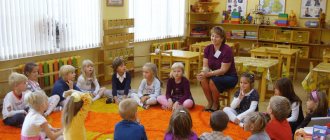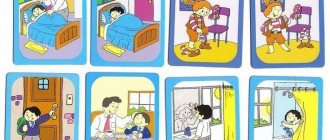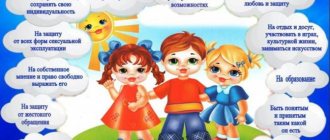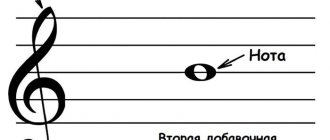Musical and didactic game as a means of developing musical hearing in older preschoolers
One of the urgent tasks in the system of musical education is the development of a child’s musicality. Each musical ability is a systemic formation, consisting of components of varying complexity; it is formed from elementary to increasingly complex components. Musical hearing refers to a person’s sensory-perceptual ability, which most actively develops as a result of musical activity.
Musical ear is the ability to perceive, imagine and comprehend a musical impression. Organized and developed ear for music is a complex single ability aimed at holistic perception and intonation of a musical work as an expression of uniform content.
B.M. Teplov noted two meanings of the term “musical ear”:
- In a broad sense - pitch hearing (melodic, timbre, dynamic, etc.);
- In a narrow sense - pitch hearing.
Pitch hearing in its manifestation in relation to a single-voice melody is called melodic. It has two bases - modal feeling and musical and auditory perceptions. In ontogenesis, melodic hearing develops as a single system, but the modal sense is ahead of musical-auditory concepts in development. Melodic hearing consists of two components - perceptual (emotional) and reproductive (auditory).
The successful development of musical ear depends on many factors, but especially on timely, as early as possible, immersion in the world of music. One of the components of the successful implementation of this pedagogical task is the correctly found way of organizing educational activities, within the framework of which the development of musical ear occurs. It is especially important to determine teaching methods in preschool age, since gaming activities dominate in this period.
For preschoolers, didactic play is always desirable, has a positive emotional connotation, and therefore its use allows, avoiding fatigue, to form the necessary skills in them, to consolidate auditory models in the mind, in a word, to carry out those pedagogical tasks that require repeated repetition of certain actions.
Goal of the work
: creating conditions for the development of musical hearing in older preschoolers in a close and exciting form - a musical and didactic game.
Tasks:
- lay the foundations for the harmonious development of the child;
- develop children's communication abilities;
- stimulate educational and cognitive activity of children;
- encourage awareness of the properties of musical speech, discrimination and reproduction of pitch movement, expressive intonations, character traits, rhythm, tempo, registers, dynamics;
- to promote the adequate application of knowledge about the means of musical expression in the analysis of a musical work.
The essence of the didactic game and the pedagogical possibilities of its application.
Didactic games are the basis of game-based learning.
Main functions of the didactic game:
- educational - a didactic game has educational content. If the game is properly organized, it reproduces the procedure and features of creative search interactions and visually models various forms of gaming activity. Game content is what determines the character and features of the game. Children know the rules of gaming behavior, the goals of the game, their basic actions and the results that are expected of them;
- developmental - a discussion, which is organized by the music director within the framework of a didactic game, develops the logical and proto-intonation (Medushevsky's term) thinking of children. In the context of play activities, children develop thinking, activity and interest in educational material, self-confidence, and play interaction creates favorable conditions for consolidating learning methods and techniques, and develops children’s creative abilities.
- motivating - gaming activity is associated with the need to successfully complete the assigned task of the game. Game moments, encouraging the solution of educational problems, create conditions for the emergence and strengthening of cognitive motives, the development of interest in the subject and educational and cognitive activity.
- communicative - the game involves active communication. In it, children recognize themselves as members of a team and learn to act in concert.
- organizational and guiding - creating optimal conditions for the implementation of educational and play interaction between children (activating the functions of game participants, maintaining interest in the problem at hand). In a musical didactic game, each child can apply his knowledge, show his understanding of the educational and cognitive task, demonstrate the ability to listen and analyze a piece of music. The rules and requirements of the game ensure coordination and coordination of the actions of preschoolers, and proper organization makes it possible to introduce children into certain roles and translate educational activities into a game plan.
Pedagogical conditions for the use of musical and didactic games.
Pedagogical conditions may include: the subject content of the academic discipline, its goals, objectives, as well as age-related characteristics of the child’s development.
The development of musical hearing of preschoolers is carried out in joint activities of the teacher and children (GCD, independent activities of children), joint activities of children, independent activities.
Psychological and pedagogical characteristics of children of senior preschool age.
In older preschool age, significant changes occur in all organs and tissues of the body. The musculoskeletal system is significantly strengthened, cardiovascular activity becomes relatively stable, and the processes of nervous excitation and inhibition become more balanced. The need for play, movement, and external impressions remains.
Cognitive needs intensify: to master knowledge, skills, and abilities, to penetrate into their essence.
During the assimilation of knowledge, abilities, and skills in older preschoolers, not only the volitional act itself is improved, but also the volitional qualities of the individual are formed.
The characteristics of the mental development of older preschoolers indicate that at this age there is a real opportunity to enrich their musical and life experience. According to modern research in children of this age:
- a full range of musical abilities develops;
- musical perception - thinking develops in the unity and interaction of intonation perception itself, awareness of music and its individual interpretation;
- interest in music is manifested more clearly than before: children not only prefer one or another type of musical activity, but are also selective about its various types;
- an evaluative attitude towards music and performing activities is formed;
- Based on the experience of perceiving music, the ability to generalize simple musical phenomena develops, the emotional sphere is enriched, and creative potential is activated.
Domestic research in recent years has noted an increase in the complexity of the reflective life of a child of senior preschool age. The child experiences his own “I”, his subjectivity, which is the basis for a personally significant perception of music and reflection in the process of musical thinking.
Important components that ensure full learning at this stage are: passion, attraction, entertainment, distraction, switching from one form to another. Such methods provide the child with the opportunity to effectively form reasonable needs, norms of behavior, and his development based on consciousness.
Children of senior preschool age can independently play musical and didactic games with each other, compose them, come up with a sequence of actions, and formulate the rules of the game.
Musical and didactic games are multifunctional. This is a gaming method of teaching, aimed at mastering, consolidating and systematizing knowledge about music, and one of the gaming forms of learning, and independent gaming activity, and a means of musical communication and development of the child.
The relationship between the methods and techniques of music education can be seen in the use of musical didactic games and aids. The combination of methods used can be different: auditory, visual clarity and the word, auditory clarity and the practical method (actions of the teacher and children), visual, auditory clarity, the word and practical actions.
Musical-didactic games differ from manuals in that they presuppose the presence of certain rules, game actions or a plot. Children can use them not only in class, but also in independent activities.
There are various classifications of games and benefits. For example, N.A. Vetlugina divides games into board games, moving games and round dance games. The basis for this classification is the difference in children's play actions.
E.P. Kostina developed musical and didactic board games for the development of musical and sensory abilities.
L.N. Komissarova divides games and aids based on the type of musical activity that is mastered with their help.
Since one of the main tasks of musical education is the development of musical abilities, it is possible to classify musical-didactic games and aids precisely on this basis - their capabilities in the development of each of the three main musical abilities: modal sense, musical-auditory concepts and sense of rhythm.
Requirements for organizing a musical didactic game:
- determine in advance the target orientation, depending on the content of the specific educational material that children must master in class;
- The goal of the lesson or the task of the stage within which the game is played should be made the goal of children’s play interaction, and the process of solving educational problems should be expressed in qualitative indicators and used to evaluate the progress and results of the game. In a didactic game, there are three levels of goals: general (enjoyment, enjoyment of the game); functional (game task); achieving a specific educational problem (define, find out, guess, etc.);
- it is necessary to take into account the learning conditions, the time allocated for the didactic game, the stages of the lesson at which the game is used;
- apply various options for musical didactic games and their possible combinations.
Techniques for creating and maintaining a game situation.
1. Preparatory - prepare children for the didactic game. They relate to the formation of the ability to develop the proposed plot, the development of skills in freely handling educational material.
2.Behavioral and playful - focused on organizing and stimulating children's play interactions. These include the following techniques:
- instructing (messages about the rules of game actions and requirements for them);
- activation of game aspects (reminder of similar situations, setting additional tasks, hints, inclusion of recognition fragments);
- cognitive-game. The concept of “cognitive-game” is used in pedagogy to characterize the cognitive processes of children in the role of a game character. The main goal of this technique is to make it easier and more natural for preschoolers to enter given role images and to correct the behavior of characters in a gaming situation. Among the mentioned techniques, one can highlight techniques that facilitate entry into the role (image): general characteristics of the role, encouragement, encouragement, question-hint; techniques for role correction (hints, leading questions, remark-questions).
There is not and cannot be some uniform procedure for summing up the results of a didactic game. The effectiveness of its implementation is determined by many pedagogical factors: taking into account the achieved level of development of abilities, training, education within collective relations and experience in game interactions. All this allows for the gradual development of children’s cognitive activity and independence during the game, expanding the range of methods and techniques of teaching and pedagogical stimulation used in this process.
The interested attitude of children to the creative process in musical and didactic games is expressed in the following indicators:
- passion for musical and gaming activities;
- degree of awareness of creative intent;
- initiative and independence of creative search when completing tasks;
- originality in the embodiment of a creative concept and the choice of means for its implementation;
- adequacy of creative manifestations to the nature of the musical work;
- the ability to involve musical and life experience in the creative process;
- the degree of completeness and artistry of the embodiment of the creative concept.
Fret feeling.
Games and aids for the development of modal sense contribute to the recognition of familiar works, determining the nature of the music, changing moods in individual parts of the work, distinguishing the genre, and assessing the correct sound of the melody. All types of games and benefits can be used here. For example:
“Mood” - certain concepts (sadness, joy, fun, dreaminess, etc.) are “voiced” by music. From several proposed passages, children choose the one that corresponds to a particular concept. Options - one piece of music and several “moods” are offered.
“Choosing the Music” - a reproduction of a portrait with a clearly expressed emotional state of the hero is offered. Children choose the appropriate one from several musical passages (and vice versa).
“Major - minor” - several small pieces of music are played. Children determine their musical mode.
“Magic petals” - from the proposed musical options and petals drawn (by the children themselves), choose those that can lull the children to sleep or wake them up. Then you can make a common panel for the bedroom and for the playroom.
“Broken Vases” - a naughty wind ran through the rooms of the castle (composer, actor and princess - “Nocturne” by J. Field, “Sweet Dream” and “Neapolitan Dance” by P.I. Tchaikovsky), the vases shook, fell and broke into small pieces pieces. Offer to collect vases and guess which vase is from whose room.
“The Magic Shred” - Y. Slonov “Clowns” and A. Grechaninov “Complaint” - two clowns Gosha and Plosha. The tailor mixed up all the pieces of fabric and does not know what color the fabric is for Gosha and what color it is for Plosha. Children must choose. Option: it rained over the circus and washed away all the colors from the clowns’ costumes. How can I help them? (color the costumes).
“Teremok” - listen to musical phrases and determine whether the hero of the fairy tale entered the teremok (sense of tonic)
“Basket” - “put” into a basket words-definitions (apples, mushrooms, etc.) that correspond to the nature of the music, genre, mood, etc.
“Draw a Rainbow” - draw a rainbow from the given musical excerpts.
“Hello” - children move in a circle to the music. If there is a “stop” at the tonic, then they greet each other, and if not, they move in all directions.
“Guessing game” - double-sided masks (fun and sad) for children. The teacher plays, and the children guess the scale by turning the picture to the teacher with the corresponding side.
Musical and auditory performances.
Games and aids for the development of musical and auditory perceptions are associated with the discrimination and reproduction of pitch movements. To activate these ideas, musical and didactic aids, board games and round dances are used. For example:
“Hide the melody” - children begin to sing a well-known song, then, according to a conventional sign, continue to sing to themselves, i.e. silently, at another sign - out loud again. One child or several children can take part in the game.
“Catch-up” or “Echo” - One “runs away”, the other “catches up” (the first sings the interval, the other repeats), as well as well-known musical and didactic games: “Steps”, “Three Little Pigs”, “Swing”, “Scientist” grasshopper”, “Jingle bells”, “Circus dogs”, “Recognize a song by two sounds”.
"Live Piano" is a game based on relative solmization. Musical educational material is first built on the basis of the trichord (ZO,
VI, RA), then the volume expands due to the addition of a major second from below (pentatonic scale). The gradual expansion of volume leads to seven-step modes of major and minor.
“Musical patterns”, “Paths”, “Relay race”, “Two friends”, “Blind musician”, “Pyramid”, “Path and slide”, “Figure skating”, “Circles and circles”, “Sparkles”, “Beads” ", "Big Guessing Game", "Concert. Let's sing from the recording" - a graphic recording of games with sounds.
Sense of rhythm.
Games and aids for developing a sense of rhythm in older preschool age continue to develop the ability to actively (motorly) experience music, perceive the compositional structure by ear, feel the emotional expressiveness of musical rhythm, and continue to develop the ability to accurately reproduce the rhythmic pattern of a work.
To convey the rhythm and character of music in movements, all types of games are used - board games, moving games (plot, non-plot), round dance, creative.
“Rhythmic echo” - the teacher claps simple rhythmic patterns, the children repeat them exactly (you can introduce footsteps).
“Clap to the beat” - a piece of music sounds; children clap, tap, or use musical instruments to emphasize the given beat.
“Musical stomps” - the rhythmic pulsation of a musical piece must be duplicated by a rhythmic pattern of movements. You can suggest beating only the strong beat and the relatively strong beat, splitting up the durations, etc.
“Horses in the Circus” - children move in a circle at a pace (coinciding in movement with quarter durations), to the same music, at a certain signal, they switch to rhythmic running (coinciding in movement with eighth durations).
“Help Dunno” - Dunno wanted to become a composer. The poet Tsvetik wrote poems, and Dunno composed songs based on them. But Guslya told him that it was impossible to perform his songs, because there was a mistake in each of them. Children need to find errors in the recording of rhythm and write or lay out the correct rhythm for a given poem.
“Detectives” - children are asked to connect with colored lines a picture of a given poem and a rhythmic pattern suitable for it. “Question and answer” - one asks the ri, and the other composes the ri. Conditions for the “answer”: its volume must correspond to the volume of the “question” (the same number of shares).
“Choose words” - choose phrases based on the proposed rhythmic pattern.
“Telephone” - children line up in a row, behind each other’s heads. The latter comes up with a rhythmic phrase and taps it with his hand on the back of the person in front. The second one passes it on to the third one, etc. The child who received the last “phone message” posts it. After that, everyone slams this turn.
“Caterpillar” - children stand in a circle. The leader sets a rhythmic pattern, the next one joins him (they reproduce the same rhythm, but together), then the three of them, etc.
“Conductor” - the “conductor” sets the time signature and says for what beat there will be a pause. The Orchestra fulfills his demands.
“Enter on time” - a piece of music sounds. The first child hits the downbeats. When repeating, other children take turns beating out a rhythmic pattern, each entering in time at the beginning of his phrase (then possible without accompaniment).
“Lanterns” - with the beginning of the music, the “lamplighter” “lights” the first “lantern” for a strong beat of the beat (he raises his hands), then walks in “quarters”. And he does this until all the lights are on. When a piece of music is repeated, the “lamplighter” “extinguishes” them (they lower their hands). “Figure skating” - children “skate” to music. The “trainer” gives commands: in pairs, arms crosswise, in a circle, jump, rotation, etc.
“Singing Hands” - after listening to a piece of music, children imagine that they are residents of a fairyland, but do not know how to speak. Bring them to the point where they can speak and sing with their hands. Children must convey tempo, dynamics, rhythm with different amplitudes, speeds and strength of movement.
“Living Picture” - remember what a museum is. Offer to organize an exhibition of “live” musical paintings. An option is animated sculptures.
And also the well-known ones - “The Wattle,” “Burn, Burn Clear...”, “We Were in the Round Dance,” “The Red Handkerchief,” etc.
Conclusion
Throughout my teaching practice, I have used musical and didactic games to develop musical hearing in preschoolers. The experience and methodological materials accumulated during this time required comprehension, systematization, and analysis of the effectiveness of application. The criterion for systematization was the focus of the gaming exercise on the development of a certain musical ability, i.e. ability that will be dominant when the conditions of this exercise are fulfilled. Some game exercises are given as examples in this work.
Practice has shown that the use of musical and didactic games for the development of musical hearing in preschoolers allows one to achieve better results, since games make it possible to turn actions that are repeated many times in classes and in independent activities into an interesting, positive, emotionally charged game.
For preschoolers, didactic play is always desirable, has a positive emotional connotation, and therefore its use allows, avoiding fatigue, to form the necessary skills in them, to consolidate auditory models in the mind, in a word, to carry out those pedagogical tasks that require repeated repetition of certain actions
Bibliography:
- Abramin G.N. Solar circle. Musical ABC - M., 1985
- Agazhanov A.P. Education of musical ear - M., 1993, v.Z
- Berezhansky P.N. Absolute ear for music - M., 2000
- Byrchenko T.S. With a song along the stairs - M., 1983
- Weiss P.F. Questions of methods of musical education of children - M., 1975
- Jacques-Dalcroze Music, fantasy, play - L., 1999
- Konovalova N.G. Musical and didactic games - M., 1982
- Kalezo M.F. Course of general, developmental and educational psychology - M., 1982
- Kurevina O.A. Synthesis of arts in the aesthetic education of children of preschool and school age - M., 2003
- Lekhina L.N. Chord tales for big and small - M., 2003
- Mikhailova N.A. Development of children's musical abilities - Yar., 1997
- Nezaykinsky E.V. On the psychology of musical perception - M., 1972
- Nezaykinsky E.V. The sound world of music - M., 1982
- Notdorf E.G. Singing and games for children - M., 1995
- Poplyanova E.M. Game canons in music lessons - M., 2002 16. Poplyanova E.M. And we play in class - M., 1994
- Radynova O.P. Musical education of preschool children - M., 2000 18. Sereda V.N. Canons - M., 1997
- Tyutyunnnkova T.E. Musical patterns - M., 2005
- Tyutyunnikova T.E. Microbe-pedestrian - M., 2005 21. Tyutyunnikova T.E. Lessons without hassle - M., 2005
- Kholopova V.N. Music theory - St. Petersburg, 2002
- Shatkovsky G.I. Development of musical hearing - M., 1996
Multimedia educational game “Seasons”
Abstract to the multimedia didactic game “Seasons”
The multimedia game allows you to:
- increase the information content of the GCD;
- stimulate learning motivation;
- increase the visibility of learning;
- realize the accessibility and perception of information through parallel presentation in its various modalities: auditory and visual;
- repeat the material from the previous lesson;
- create comfortable working conditions for children in the educational activities.
The use of a multimedia didactic game in educational activities activates the emotional impact on students by:
firstly, the learning environment is created with a visual representation of information in color;
secondly, the use of animation is one of the effective means of attracting attention and stimulating the emotional perception of information;
thirdly, the visual presentation of information in the form of photographs and pictures, with sound, has a stronger emotional impact on a person than the traditional one, since it helps to improve the understanding and memorization of the physical and technological processes shown on the screen.
From the portal administration: a demo version is presented for review. The full version will be in the multimedia album of the virtual exhibition, which each participant will receive.
Goal: development and activation of children’s cognitive abilities through the use of modern information technologies.
Tasks:
q Form a holistic picture of the world around you; Show the relationship between the seasons and living organisms;
q Activate the cognitive and speech activity of children;
q Improve the ability to write grammatically correctly and consistently construct your statements;
q Develop memory, attention, verbal - logical thinking, fine motor skills, visual and auditory perception.
The multimedia didactic game “Seasons” is intended for children 4-5 years old. Can be used in kindergartens in the middle group, and by parents for home viewing.
Development program: Power Point
Equipment: interactive whiteboard, projector, laptop.
Rules of the game:
- Ø Riddles or questions are written on the slides. It is necessary to explain the answer and click on the correct answer with the mouse;
- Ø If the answer is correct, a picture will appear and you will hear a sound, and if the answer is incorrect, the picture will disappear, change color or rotate;
- Ø To go to the next slide, click on the “>” button in the lower right corner; to return to the previous slide, click on the “<” button in the lower left corner. To repeat the game, press the “house” button again.
Usage form:
- when working with an interactive whiteboard; individual work with a computer.
Method of use:
- multimedia presentation is used for group (as part of a lesson) and individual training;
- at the end of viewing a certain section, children are offered a speech logic task;
- To consolidate the material, you can choose to show only the necessary slides and build a conversation on their basis, organize a situational conversation.
Educational effect:
q Speech development: enrichment of vocabulary, development of coherent speech, development of word formation functions.
q To consolidate knowledge about the world around us.
q Learn to guess riddles about the seasons;
q Strengthen forward and backward counting to 5, the ability to correlate the number with the number of objects;
q Repeat the names of migratory birds;
q Repeat the names of animals that hibernate in winter;
q Name trees and find a leaf from this tree;
q Repeat the signs of spring;
q To consolidate the ability to determine the time of year by a person’s clothing.
Practical significance:
- it becomes possible to optimize and increase the efficiency of the correctional and developmental process, to individualize the education of children with different levels of cognitive development;
- children consciously perceive the material being studied, generalize, consolidate and remember it firmly;
- Motivation increases, positive emotions are created due to the dynamism of the material: bright animated pictures attract the attention of children for a long time;
- multimedia presentation allows you to simulate signs of the season that cannot be seen at the moment (leaf fall, rain, snow, etc.);
- The use of a multimedia game makes it possible to make GCDs emotionally charged, attractive, arouse keen interest in the child, and are an excellent visual aid and demonstration material, which contributes to good performance;
- provides for the implementation and integration of educational areas: “Health”, “Physical Education”, “Cognition”, “Communication”, “Reading Fiction”.
Description:
(Slide 1) title
(Slide 2-3) goal, objectives, rules of the game
(Slide 4) Now we will talk about the seasons. Listen carefully to the riddle:
I bring the harvests, I sow the fields again, I send the birds to the south, I strip the trees, But I do not touch the pines and fir trees. I – ... (autumn)
Now choose an answer option. Right. What did you see in the picture? What color are the leaves? How are the children dressed? How many Christmas trees are there in the picture?
(Slide 5) What time of year is shown in the picture? (autumn) By what signs did you determine? There are 3 trees in the picture. Name them. (Apple tree, rowan tree, birch.) Name a tree that does not correspond to the season? (birch) Why? (green leaves)
(Slide 6) In autumn, the leaves turn yellow and fall off. What is this natural phenomenon called? (leaf fall) What is the name of the tree on the slide? (oak) Find a leaf from this tree? Right. This leaf is from an oak tree, so what is it? (oak) From maple - maple, from birch - birch, from rowan - rowan.
(Slide 7) Listen to the following riddle:
Powdered the paths
I decorated the windows,
Gave joy to children
And I went for a sledding ride. (Winter)
Now choose an answer option. Right. What did you see in the picture? What do the children do?
(Slide 8 ) In autumn, all nature, animals, insects prepare for winter. What animal hibernates in the fall and sleeps all winter? Choose an answer. (Bear, badger, hedgehog) Correct. How do animals prepare for hibernation? (they eat a lot, accumulate fat under the skin) The fox and the wolf do not hibernate.
(Slide 9 ) Guess the riddles. Click on the square and check the answer.






